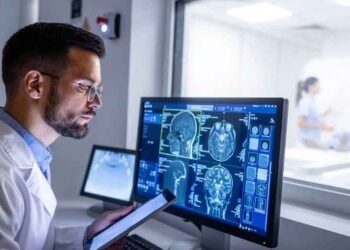In today’s evolving healthcare landscape, you face constant pressure to improve patient care while reducing costs. Technology offers powerful solutions to help you streamline operations and cut expenses across your medical practice or facility. From electronic health records to telemedicine platforms, innovative tools are transforming how you deliver care and manage resources. Maxim Gorin explores key ways technology can help you reduce operational costs while maintaining high-quality care.
How Technology Streamlines Medical Operations
Enhanced Patient Management Systems
Technology has revolutionized patient management in healthcare facilities. Electronic Health Records (EHRs) have replaced cumbersome paper files, allowing instant access to patient histories, test results, and treatment plans.
This digital transformation saves time and reduces the risk of errors associated with manual record-keeping. Additionally, automated appointment scheduling systems minimize no-shows and optimize clinic flow, leading to improved operational efficiency.
Telemedicine and Remote Monitoring
The advent of telemedicine has dramatically changed the landscape of healthcare delivery. Virtual consultations enable physicians to reach patients in remote areas, reducing the need for physical infrastructure and associated costs.
Remote monitoring devices allow continuous tracking of patients’ vital signs, enabling early intervention and reducing hospital readmissions. This proactive approach not only improves patient outcomes but also significantly cuts down on operational expenses.
AI-Powered Diagnostics and Decision Support
Artificial Intelligence (AI) is making significant inroads in medical diagnostics and decision-making processes. AI algorithms can analyze medical images with remarkable accuracy, often outperforming human specialists in detecting certain conditions. This technology not only speeds up the diagnostic process but also reduces the workload on medical professionals, allowing them to focus on complex cases and patient care.
Moreover, AI-powered clinical decision support systems help physicians make more informed treatment choices, potentially reducing medical errors and improving overall healthcare quality.
The Impact of Automation on Cutting Operational Expenses
Streamlining Administrative Tasks
Automation plays a pivotal role in reducing operational costs within healthcare facilities. By implementing sophisticated software systems, medical institutions can significantly decrease the time and resources spent on administrative tasks.
For instance, automated scheduling systems can efficiently manage patient appointments, reducing no-shows and optimizing staff time. Similarly, automated billing processes can expedite insurance claims and reduce errors, leading to faster reimbursements and improved cash flow.
Enhancing Inventory Management
Another area where automation proves invaluable is inventory management. Smart inventory systems can track medical supplies in real-time and automatically reorder when stocks run low.
This not only prevents costly overstocking but also ensures that critical supplies are always available when needed. By minimizing waste and optimizing storage, healthcare providers can realize substantial savings on procurement and storage costs.
Improving Patient Care Efficiency
Automation also extends to patient care, where it can both improve outcomes and reduce expenses. Electronic health records (EHRs) allow for seamless sharing of patient information across departments, eliminating redundant tests and procedures.
Moreover, automated reminders for follow-ups and medication adherence can reduce readmissions, ultimately lowering costs associated with prolonged or repeated treatments. By leveraging these technological advancements, healthcare providers can simultaneously enhance patient care and trim operational expenses.
Using Data Analytics to Optimize Medical Workflows
In healthcare, data analytics has emerged as a powerful tool for streamlining operations and reducing costs. By leveraging advanced analytics techniques, medical facilities can gain valuable insights into their workflows, identify inefficiencies, and implement targeted improvements.
Enhancing Resource Allocation
Data analytics enables healthcare providers to optimize resource allocation by analyzing patient flow patterns, appointment scheduling, and staff utilization. By identifying peak hours and bottlenecks, administrators can adjust staffing levels and redistribute resources more effectively.
This data-driven approach not only reduces wait times but also minimizes operational costs associated with overstaffing or underutilization of equipment.
Predictive Maintenance and Equipment Management
Implementing predictive analytics in medical equipment maintenance can significantly reduce unexpected breakdowns and associated costs. By analyzing usage patterns and performance data, healthcare facilities can schedule preventive maintenance at optimal times, extending the lifespan of expensive medical devices and reducing downtime.
This proactive approach not only saves money but also ensures that critical equipment is available when needed, improving patient care and operational efficiency.
Optimizing Inventory Management
Max Gorin considers Data analytics crucial in streamlining medical supplies and pharmaceuticals inventory management. By analyzing usage trends, expiration dates, and supply chain data, healthcare facilities can maintain optimal stock levels, reduce waste, and prevent shortages.
This data-driven inventory control not only cuts costs but also ensures that essential supplies are always available, contributing to better patient outcomes and operational efficiency.
Leveraging Cloud Computing to Reduce IT Costs
Cloud computing offers healthcare organizations a powerful way to streamline operations and cut expenses. By migrating to the cloud, medical facilities can significantly reduce their IT infrastructure costs while improving scalability and accessibility.
Eliminating On-Premise Hardware
One of the primary benefits of cloud adoption is the elimination of costly on-premise servers and data centers. Healthcare providers can offload the burden of maintaining and upgrading hardware, resulting in substantial savings on equipment, power, and cooling costs.
Pay-as-You-Go Flexibility
Cloud services typically operate on a pay-as-you-go model, allowing healthcare organizations to scale resources up or down based on demand. This flexibility ensures that you only pay for what you use, optimizing IT spending and avoiding over-provisioning of resources.
Enhanced Data Security and Compliance
While some may worry about security in the cloud, reputable providers offer robust security measures that often surpass on-premise solutions. Cloud platforms can help healthcare organizations meet strict compliance requirements like HIPAA, reducing the risk of costly data breaches and regulatory fines.
Improved Collaboration and Accessibility
Cloud-based solutions enable seamless collaboration among healthcare professionals, regardless of location. This improved accessibility can lead to more efficient workflows, reduced redundancies, and ultimately, lower operational costs across the organization.
Emerging Technologies Transforming the Medical Industry
Artificial Intelligence and Machine Learning
Artificial intelligence (AI) and machine learning (ML) are revolutionizing healthcare operations. These technologies enhance diagnostic accuracy, streamline administrative tasks, and optimize resource allocation.
By analyzing vast amounts of medical data, AI algorithms can identify patterns and predict outcomes, leading to more personalized and effective treatments. Machine learning models are also being employed to automate routine tasks, reducing human error and freeing medical professionals to focus on patient care.
Telemedicine and Remote Patient Monitoring
The rise of telemedicine has significantly improved access to healthcare services, particularly in rural or underserved areas. Virtual consultations and remote patient monitoring devices allow for continuous tracking of vital signs and early detection of health issues.
This proactive approach enhances patient outcomes and reduces the need for costly emergency interventions. Telemedicine platforms integrate with electronic health records (EHRs) to coordinate care and reduce operational expenses associated with traditional in-person visits.
Robotics and Automation in Healthcare
Robotic systems are increasingly used in surgical procedures, pharmacy operations, and patient care. Surgical robots offer enhanced precision and minimally invasive techniques, leading to faster recovery and reduced hospital stays.
Automated pharmacy systems improve medication management, reducing errors and optimizing inventory control. Inpatient care robots assist with lifting and transporting patients, minimizing the risk of injury to healthcare workers and improving overall efficiency in medical facilities.
Final Thoughts
Maxim Gorin understands that embracing technology is no longer optional as you navigate the rapidly evolving healthcare landscape—it’s imperative. By leveraging innovative solutions, you can significantly streamline operations and reduce costs across your medical practice or facility. The potential for efficiency gains is vast, from AI-powered diagnostics to automated administrative processes.












